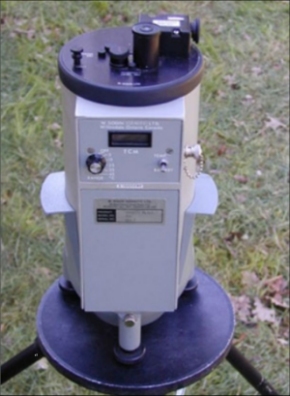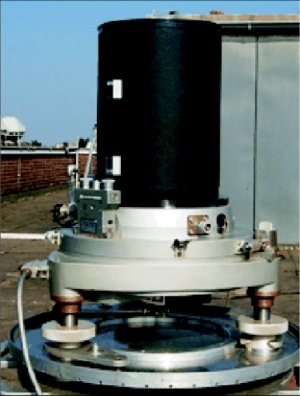Integration of Physical Observation Components by Spherical Cap Harmonics Parametrization: 2nd stage of the DFHRS Concept and Software (Version 5.0)
The extension of DFHRS concept and software to physical observation types - such as terrestrial, air- or space-borne gravity measurements (for terrestrial gravity meter see fig. 3), or physical observation types taken from geopotential models (GPMs), e.g. EGM 2008 - is based on a regional spherical cap harmonic parameterization (SCH) of the Earth’s gravitational potential (V).

|
 |
The benefit of an SCH-parameterization (3) with a local cap pole and a limited cap size area, instead of an ordinary global spherical harmonic (SH), is that the same resolution of V can be achieved with SCH by a much smaller number of parameters than with SH. Thus, for a 2 mm resolution for the HRS, a degree of 7200 for the SH parameterization by (Cn,m,Sn,m) is required, while for a cap size area of 100 km a degree of only kmax=80 is enough in the case of an SCH parametric model. Therefore, SCH is the key model for enabling the computation of high resolution HRS in the 2nd stage of the DFHRS research and development, meaning an integrated over-determined HRS-computation for all types of geometrical and physical observations. The representation of gravitational potential V of the Earth in terms of SCH with parameters (C'n(k),m,S'n(k),m) reads:
|
\begin{array}{l}
V(r,\lambda ',\theta ')=
\sum\limits_{k=0}^{k\max }\left( \frac{a}{r} \right) ^{n(k)+1} \sum\limits_{m=0}^{k}(C'_{n(k),m} \cdot \cos m\lambda '+S'_{n(k),m'} \cdot \sin m\lambda ')\cdot P'_{n(k),m} (\cos \theta ') \end{array}
|
(3) |
Here the space position refers to the triple of spherical cap coordinates (r, λ', θ' ). In
the following, the observation equation for terrestrial and air- or space-borne
gravity observations gp is briefly worked out.
The gravity observation gp at the Earth surface point P (taken with a gravity
meter, see fig. 3, left) is referring to the local astronomical vertical
(LAV) system, and, therefore, for the respective observed 3D gravity vector
we have in total:
|
\mathbf{g}^{LAV} =\lbrack 0,0,-g_{P} ]^{T}
|
Original gravity observation and vector | (4a) |
The astronomical vertical (Φ=B+ξ, Λ=L+η/cos(B)) is set up by the ellipsoidal vertical (B, L) and the deflections - from the vertical (ξ,η). The original vector gLAV (4a) is first rotated to the Earth-centred Earth-fixed system (ECEF) using the astronomical direction (Φ,Λ) from a geopotential model. In that coordinate frame, the centrifugal part of gLAV (4a) is removed, and so the original observation (4a) is strictly reduced with respect to the vertical deflections (“topography”) and the centrifugal acceleration. We thus arrive at:
|
\mathbf{g}_{red}^{LGV} =\lbrack g_{N} ,g_{E} ,g_{r} ]^{T}
|
Reduced gravity observation vector. | (4b) |
The observation vector
|
\mathbf{g}_{grav}^{SCH} =\lbrack \frac{1}{r} \cdot \frac{\partial V}{\partial \theta '} ,\frac{1}{r\cdot \sin \theta '} \cdot \frac{\partial V}{\partial \lambda } ,\frac{\partial V}{\partial r} ]^{T}
|
(4c - 1) |
The principal component of the reduced observed gravity observation
|
\begin{array}{l}
g_{grav_{r}}^{SCH} +v_{g} = \frac{GM}{{r}^{2}} \cdot
\sum\limits_{k=0}^{k\max}\left( \frac{a}{r} \right) ^{n(k)+1} (n(k)+1) \cdot \sum\limits_{m=0}^{k}(C'_{n(k),m} \cdot \cos m\lambda '+S'_{n(k),m'} \cdot \sin m\lambda ')\cdot P'_{n(k),m} (\cos \theta ')
\end{array}
|
(4c - 2) |
With vg (4d) we describe the observation correction of the gravity observation in the integrated adjustment approach. By introducing the disturbance potential
|
h-N_{Normal} =N_{QG} =\frac{(V-V_{ref} )_{P} }{\gamma _{Q} } =\frac{T_{P} }{\gamma _{Q} }
|
(5a) |
|
\xi =-\frac{\partial N_{QG} }{\partial B} \cdot \frac{\partial B}{\partial s_{N} } =-\frac{\partial B}{\partial s} \cdot \frac{\partial N_{QG} }{\partial B} =\frac{-1}{(M+h)} \cdot \frac{1}{\gamma _{Q} } \cdot \frac{\partial }{\partial B} T_{p} =\frac{-1}{\gamma _{Q} \cdot (M+h)} \cdot (\frac{\partial T}{\partial B} )_{P}
|
(5b) |
|
\eta =-\frac{\partial L}{\partial s} \cdot \frac{\partial N_{QG} }{\partial L} =\frac{-1}{(N+h)\cdot \cos B} \cdot \frac{1}{\gamma _{Q} } \cdot \frac{\partial }{\partial L} T_{P} =\frac{-1}{\gamma _{Q} \cdot (N+h)\cdot \cos B} \cdot (\frac{\partial T}{\partial L} )_{P}
|
(5c) |
|
C'_{n(k),m} +v=\hat{C}
|
and |
S'_{n(k),m} +v=\hat{S}
|
(6) |
The integrated DFHRS approach, represented by eqs. (3-6), is a far reaching alternative to the model
described by (2a) to (2f)), because it allows both “geometrical” and “physical” observations.
The integrated approach is presently being investigated and implemented in the DFHRS software
version 5.0.
Formula (5a) is used to derive the QGeoid NQG from the estimated SCH-parameters. The QGeoid model
NQG or a grid (computed by the DFHRS approaches (1–2f) or (3–6), respectively) can be transformed
to a Geoid-model by the equation:
|
N_{G} =N_{QG} +\frac{\bar{g}-\bar{\gamma} }{\bar{\gamma}}\cdot H
|
(7) |

